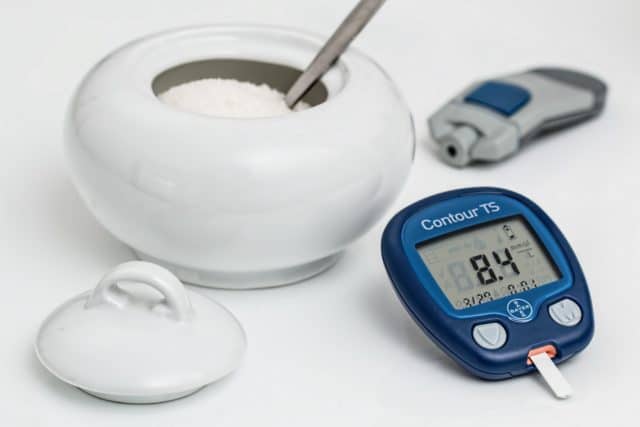Last year, I started feeling a burning sensation on the bottom of my feet occasionally and I passed it off as just being flat-out tired from standing for extended periods of time while at work. Little did I know what was about to happen and why it was happening.
Studies show that only one out of every eight people who have pre-diabetes are aware they have it. It’s easy to see how so many people are oblivious to the fact that they may have slightly high sugar levels. As a result, they fail to make adjustments in their diets and exercise regimen in order to prevent them from coming down with type 2 diabetes.
Most experts agree that even losing a modest amount of weight and increasing exercise can help you lessen the chances that you’ll acquire type 2 diabetes even if your blood sugar is a little bit out of control at the present time. So, the key to preventing it is to know what your sugar levels are in the first place so you can make adjustments if needed and stay committed to diabetes prevention.
Throughout the world, approximately one out of every nine adults has diabetes. This disease is destined to be one of the leading causes of death by the year 2030. Most people with this disease have what’s called adult onset or type 2 diabetes. It occurs when your body can’t produce enough insulin to be able to convert your blood sugar into the energy your body needs.
I was a carbohydrate fanatic all my life. It started when I was in my early twenties. I needed bursts of energy for my grueling workout routines and from everything I researched at the time, complex carbs were the answer to my sustained energy needs. I was in excellent shape until I hit my mid-thirties.
Never in a million years would I have thought this mode of thinking would come back to bite me hard on the buttocks many years later. I soon found my feet burning non-stop after a a heavy carbohydrate meal, so I knew something was wrong. I rushed to my local Walgreens for a blood sugar level test kit and began measuring my blood sugar throughout the day. What I found was shocking!
In the morning, after fasting, my blood sugar was a fairly normal 85 to 90. However, two hours after a heavy carbohydrate breakfast containing approximately 80 grams of the complex (the good kind), my blood sugar level was spiking between 140 to 180, consistently. I knew there was a problem but I tried to handle it on my own, through diet and exercise.
There was only one big problem; I was not able to stick to a strict lower-carb diet and my old habits of having a few rum and cokes and churrasco or T-Bone steak on the weekends with friends and family continued. I feel like such an idiot as I write this!
Why? Because I was killing myself right in front of my very own eyes! Over the years, I had ballooned from 190 pounds of solid muscle to 260 pounds of muscle covered by a huge mass of fat all over my body. Ouch!
How Do You Test for Diabetes Type 2?
After researching Google, I really thought I might be headed towards type 2 diabetes. I was deteriorating rapidly and a few weeks later, I woke up with numbness in my feet. At this point I was really frightened and I immediately scheduled an appointment with my doctor. I noticed my blood circulation had become very poor and knew something had to change, and fast!
He ran blood tests and discovered my hemoglobin A1C test showed numbers indicating I was on my way to having pre-diabetes. This A1C test measures the average of blood sugar present in your body for the previous three months. My reading was at 5.7 which indicated I had pre-diabetes. Anything more than 6.7 would have meant that I had diabetes. Yikes! I was somewhat relieved I didn’t have diabetes but I definitely wasn’t “out of the woods” just yet.
My doctor informed me that sometimes, people with borderline A1C readings suffer what’s called “peripheral neuropathy,” a type of nerve damage oftentimes caused by elevated blood sugar which in turn, causes numbness in the feet and hands. In other words, your nerves start starving for oxygen because there is an abnormal amount of sugar interfering with oxygen carried to the nerves. This eventually causes temporary or permanent damage. Most actual diabetics suffer from peripheral neuropathy at some point in their lives.
In my case, the damage seemed temporary, or at least I hoped that’s what it was! I eventually went on to have type 2 diabetes with an A1C level of 6.7!
Here I am today, exactly one year later and although the numbness and burning has drastically improved, I still feel a slight numbness in my feet every single morning that goes away once I start walking around the house. My blood circulation has also improved quite a bit. A year ago, I would sit on the couch and my feet would get extremely cold because my circulation was poor. Now, they are constantly very warm to the touch.
What’s the moral of the story here? I got busy and changed my lifestyle in order to avoid prediabetes and to get rid of my peripheral neuropathy.
I used common sense with the hope that it would change my life completely. It worked!
If you are headed down the ugly path of either or both, the following tips may help you get on the right path to recovery or avoidance of them altogether!
In summary, these were my symptoms:
- Burning sensation on the soles of my feet that kept getting worse, especially after a sugary or high-carb meal
- Sharp pains in my feet
- Slight loss of hair on my feet, hands, and arms due to lack of circulation
- Numbness in hands, arms, and feet
- Pins and needles feelings in both arms after sugary or high-carb meals
- Blood sugar readings that were spiking, sometimes as high as 195 after a very high-carb meal such as spaghetti and meatballs
Physicians gave me this diagnosis:
- My AC1 hemoglobin level was dangerously creeping into “pre-diabetes land”
- I had peripheral neuropathy as a result of my continual spiking sugar levels
- Nerve conduction tests proved that I have minor nerve damage that would or would not completely heal
Physicians recommended:
- A lower carbohydrate diet
- To stop drinking that good ‘ol sugary rum
- To avoid sweets
- To exercise regularly (at least 4 times a week for 20 minutes, minimum)
- To lower my cholesterol naturally through changes in diet (they suspected my circulation was suffering due in large part to my high triglyceride levels) and exercise
- To lose a lot of weight!
- To be patient while my body tried to heal itself (to get rid of numbness, burning of feet and pins and needles)
- To minimize stress in my life
- To come back in a few months to re-examine me
Here’s what I did:
- I switched from rum to Michelob Ultra beer and drastically cut down my drinking to only once every two weeks or so (only one six-pack!)
- I virtually eliminated red meat from my diet
- I cut my carb intake in half!
- I exercised regularly (3 to 4 times a week for 20 to 40 minutes)
- I lost a lot of weight (30 pounds to be exact in 4 months)!
- I cut back on my work hours and felt less stressed
- I stopped drinking my two cups of coffee every day (I’m caffeine sensitive and it was obviously hurting my circulation)
Here are my results so far, after a year:
- The numbness on the soles of my feet is almost gone!
- I only feel discomfort on the bottom of my feet after a rare high-carb meal (no more burning)
- No more pins and needles on my arms
- I lowered my triglycerides by 200 points, down to 196! Yippee!
- I have noticed my circulation is excellent ( I can see thick veins in my hands and feet for the first time in many years)
- My sugar levels are not spiking anymore, even when I have an occasional high-carb meal (approx. 120 grams of carbs) such as my wife’s specialty pasta dish with shrimp!
- My AC1 level dropped to 5.1
- My hair is growing normally on my hands and feet
As far as I’m concerned, the keys to avoiding pre-diabetes and making sure you never get peripheral neuropathy are:
- Monitoring your blood sugar levels and immediately making lifestyle adjustments whenever necessary to keep them under control
- Not eating more than 40 to 60 grams of complex carbs per meal (no more than 200 grams per day)
- Eating sweets only on rare occasions
- Lowering your triglycerides to a normal range (under 199)
- Reducing stress levels
- Avoiding caffeine if you are sensitive to this chemical like I am (it constricts your veins, reducing blood flow and sometimes causes peripheral neuropathy)
- Exercising regularly
So, can prediabetes cause peripheral neuropathy? Without a doubt, yes!
Taking it one step further, even glucose intolerance can get those tootsies and hands feeling numb! Impaired glucose intolerance basically means your body does not process sugars in a normal fashion, causing abnormal spikes in your blood sugar. This can cause your nerves to start starving for much-needed oxygen.
How to Reduce Your Blood Glucose Level
 The keys to managing or preventing prediabetes and type 2 diabetes is to reduce your blood glucose level by making smart diet choices that don’t include the obvious; simple sugars! Also, keep in mind that low glycemic carbohydrates such as non-starchy veggies, stone-ground wheat and beans can be very beneficial while high glycemic carbs such as potatoes and rice can wreak havoc on your body and retard your progress.
The keys to managing or preventing prediabetes and type 2 diabetes is to reduce your blood glucose level by making smart diet choices that don’t include the obvious; simple sugars! Also, keep in mind that low glycemic carbohydrates such as non-starchy veggies, stone-ground wheat and beans can be very beneficial while high glycemic carbs such as potatoes and rice can wreak havoc on your body and retard your progress.
Exercising at least 30 minutes a day, five days a week can also help your body process sugars much more efficiently while lowering the frequency of blood sugar spikes.
If you think you have or are in danger of heading toward prediabetes, consult your physician immediately and get it under control. The sooner you get the help, the easier it will be to delay prediabetes, diabetes and any peripheral neuropathy associated with elevated glucose levels.
If you have burning feet, don’t hesitate to get it checked out; you are probably in the same position I was in just a short year ago. It can be fixed!




